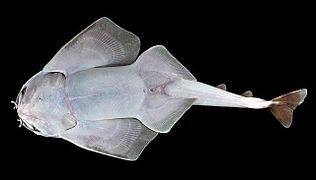Sand devil
| Sand devil | |
|---|---|

| |
| Scientific classification | |
| Domain: | Eukaryota |
| Kingdom: | Animalia |
| Phylum: | Chordata |
| Class: | Chondrichthyes |
| Subclass: | Elasmobranchii |
| Subdivision: | Selachimorpha |
| Order: | Squatiniformes |
| Family: | Squatinidae |
| Genus: | Squatina |
| Species: | S. dumeril
|
| Binomial name | |
| Squatina dumeril Lesueur, 1818
| |

| |
| Range of the sand devil[1] | |
The sand devil or Atlantic angel shark (Squatina dumeril) is a
pectoral and pelvic fins give it a ray
-like appearance. There is a band of enlarged thorns running along the middle of its back. It is gray or brown in color, with scattered small dark spots. This species reaches 1.2–1.5 m (3.9–4.9 ft) in length.
The diet of the sand devil consists mainly of small
fisheries
.
Taxonomy and phylogeny
French
naturalist Charles Alexandre Lesueur described the sand devil in an 1818 volume of Journal of the Academy of Natural Sciences of Philadelphia. Previously, it had been regarded as the same species as the European Squatina squatina. Lesueur based his account on an adult male 1.2 m (3.9 ft) long caught off the eastern United States, and named the species in honor of André Marie Constant Duméril.[2]
Ma, around the time that the Isthmus of Panama formed. The rise of the Isthmus likely split the ancestral angel shark population, leading to their becoming separate species.[3]
Description
The sand devil has a flattened, moderately narrow body with greatly enlarged
pectoral and pelvic fins. The skin folds along the sides of the head have smooth margins, without lobes. The large eyes are placed on top of the head and have prominent spiracles behind. The nostrils bear thin, pointed barbels with smooth or slightly fringed margins. The wide mouth is positioned terminally on the head. The jaws contain 10 upper and 9 lower tooth rows on each side, with toothless gaps at the middle. Each tooth has a broad base and a single pointed cusp with smooth edges. There are five pairs of gill slits located on the sides of the head.[4][5]
The pectoral fins are broad and angular with narrow rear tips; the front of the pectoral fin is separate from the head, forming a triangular lobe. The two
caudal peduncle. The dorsal coloration varies from greenish or bluish gray to reddish brown, with a scattering of small, darker spots and sometimes irregular splotches; the underside is uniformly pale. This species reaches 1.3–1.5 m (4.3–4.9 ft) in length and at least 16 kg (35 lb) in weight.[4][5]
-
The sand devil is a ray-like shark with a color pattern of many small dark spots on a gray-brown background.
-
Underside
-
Jaws
-
Jaws
-
Central teeth
-
Lower teeth
Distribution and habitat
The sand devil is found in the northwestern
slope.[4]
Off the eastern
inshore, down to a depth of 90 m (300 ft). In winter and spring, it is found around the outer continental shelf at depths greater than 90 m (300 ft); individuals have been recorded as far as 140 km (87 mi) from land and 1,290 m (4,230 ft) deep.[4]
Biology and ecology

The sand devil is an

Like other angel sharks, the sand devil is
sexually mature at around 93 and 86 cm (37 and 34 in) long respectively; the fact that females mature at a smaller size than males is unusual among sharks.[10]
Human interactions
Though not normally aggressive towards humans, the sand devil can inflict serious wounds if provoked. Its
least concern.[1]
References
- ^ . Retrieved 18 November 2021.
- ^ Lesueur, C.A. (1818). "Description of several new species of North American fishes". Journal of the Academy of Natural Sciences of Philadelphia. 1 (2): 222–235, 359–368.
- PMID 19647086.
- ^ ISBN 978-0-19-539294-4.
- ^ ISBN 92-5-101384-5.
- S2CID 54807345.
- ^ doi:10.3354/ab00214.
- ^ Baremore, I.E.; Murie, D.J.; Carlson, J.K. (2008). "Prey selection by the Atlantic angel shark Squatina dumeril in the northeastern Gulf of Mexico". Bulletin of Marine Science. 82 (3): 297–313.
- JSTOR 3273282.
- ^ PMID 20557624.
External links
Wikimedia Commons has media related to Squatina dumeril.







